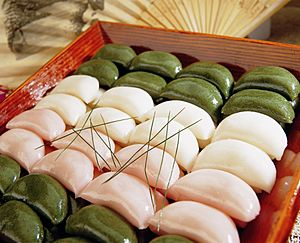Songpyeon facts for kids
 |
|
| Type | Tteok |
|---|---|
| Place of origin | Korea |
| Serving temperature | 15–25 °C (59–77 °F) |
| 220 kcal (921 kJ) | |
| Other information | Food related to Chuseok |
| Korean name | |
| Hangul |
송편
|
|---|---|
| Hanja | |
| Revised Romanization | songpyeon |
| McCune–Reischauer | songp'yŏn |
| IPA | [soŋ.pʰjʌn] |
Songpyeon (송편) is a special traditional Korean food. It is a type of small rice cake called tteok. People in Korea traditionally eat songpyeon during the autumn harvest festival called Chuseok. It is a well-known symbol of traditional Korean culture. The first records of songpyeon are from the Goryeo period, a long time ago in Korean history.
Contents
What is Songpyeon?
Songpyeon are rice cakes shaped like a half-moon. They usually have sweet fillings inside. Some common fillings are soybeans, cowpeas, chestnuts, jujubes, red beans, sesame seeds, or honey.
These rice cakes are steamed over a layer of pine needles. This gives them a special taste and a fresh smell, like pine trees. The name "songpyeon" comes from the pine needles. "Song" means pine tree, so songpyeon means "pine cakes."
Songpyeon and Korean Culture
Songpyeon is a very important part of Chuseok celebrations for Korean families. In the past, families would make songpyeon using freshly harvested rice. They would then offer it to their ancestors on the morning of Chuseok. This was a way to thank them for a good harvest during a special ceremony called charye.
Families also share songpyeon with other relatives and close neighbors. Giving these rice cakes is seen as a sign of respect. It is also believed to help avoid bad luck for the family.
Songpyeon is placed on a table with other foods like newly harvested fruit and taro. These three foods have special meanings. Songpyeon represents the fruit of the heavens. Fruit represents the fruit of the earth. Taro represents the fruit from underground.
People also say that songpyeon represents the moon and wishes. Many people make a wish while they are making and eating it. There are many stories about why songpyeon is shaped like a half-moon instead of a full moon. A common belief is that Korean ancestors thought a full moon could only get smaller. But a half-moon would grow and become full. This was seen as a sign of plenty and good fortune.
There's an old Korean saying: if you make beautifully shaped songpyeon, you will find a good husband or wife. Or, you will have a beautiful baby!
How to Make Songpyeon
To make songpyeon, you mix rice flour with salt and hot water. You knead it until it becomes a smooth dough. Then, you tear off small pieces of the dough. Roll each piece into a ball and make a dent in the middle with your thumb.
Next, you put your chosen filling inside the hollow center. After that, you seal the ball closed and shape it. The rice cakes are steamed on top of pine needles for about 20 to 30 minutes. After steaming, they are rinsed with cold water. This helps them stay chewy. Finally, the rice cakes are dried and often brushed with sesame oil.
Steaming songpyeon on pine needles gives them a unique taste and smell. It also stops the rice cakes from sticking together while they steam. Pine trees also produce something called phytoncide. This helps to kill germs and keeps the rice cakes from spoiling.
An old Korean medical book called Dongui Bogam says that pine needles also have good effects on the food.
Different Kinds of Songpyeon by Region
Even though songpyeon has the same cultural meaning everywhere, its color, shape, ingredients, and even thickness can be different across Korea.
Chungcheong Province Songpyeon
Chungcheong Province grows a lot of pumpkins. So, this region is famous for its pumpkin songpyeon. Dried pumpkins are ground into a powder. This powder is then mixed with rice flour to make the dough. The rice cakes are often shaped like small pumpkins. They are sweet and have a bright color.
Gangwon Province Songpyeon
Gangwon Province has many potato crops and oak trees. Because of this, it is known for its potato songpyeon and acorn songpyeon. These rice cakes are made with potato starch and acorn powder. Songpyeon from this region are usually flat. They have ridges from being pressed down with fingers. In a city called Gangneung, people even leave their handprints on the rice cakes!
Gyeongsang Province Songpyeon
Songpyeon made in Gyeongsang Province are usually bigger than those from other areas. A popular type here is ramie songpyeon. It has boiled ramie leaves mixed into the rice cakes to make them healthier.
Jeju Province Songpyeon
On Jeju Island, a common filling for songpyeon is sweetened peas. Sometimes, the songpyeon are shaped with a dip in the middle. This makes them look like a volcanic crater. After steaming, they are often pan-fried.
Jeolla Province Songpyeon
Songpyeon from Jeolla Province sometimes includes arrowroot starch mixed with rice flour for the dough. Jeolla Province is also known for its flower songpyeon. These are made with natural colors and shaped by hand or with a mold to look like flowers.
Seoul's Osaek Songpyeon
Seoul is famous for its small, five-colored songpyeon, called osaek songpyeon. The five colors are white, brown, pink, green, and yellow. They represent the balance of nature. White songpyeon has no added colors. The other colors come from natural ingredients. Brown is made with cinnamon. Pink comes from strawberry or omija syrup. Green is made with mugwort. Yellow comes from gardenia seeds.
North Korean Songpyeon
In Pyongan Province in North Korea, the traditional songpyeon is called seashell songpyeon. It gets its name because it is shaped like a seashell. The filling for this songpyeon is sesame seeds, sugar, and soy sauce.
See also
 In Spanish: Songpyon para niños
In Spanish: Songpyon para niños

